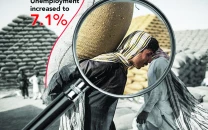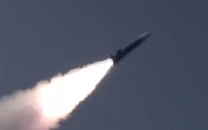Glacier melting and hydroelectric uncertainty in South Asia
The future of power production in South Asia lies in hydroelectric generation.

The writer is a former chairperson of the Higher Education Commission
Glaciers are melting faster in the Himalayas than anywhere else in the world due to global warming. Between 2003 and 2009, the Himalayan glaciers lost 260 gigatonnes of water each year, causing one-third of the global sea level rise, as well as catastrophic floods in the Indus, Ganges and Brahmaputra rivers. The warming climate increases land and sea temperatures, as well as leading to external events, like draughts, hurricanes and floods. Pollution, mostly from India and China, is accelerating the melt. An ‘Asian Brown Cloud’, formed from the 2m metric tonnes of carbon soot and dark particles sprayed into the atmosphere every year, warms the air. Such emissions over the past two decades will contribute 0.1 degree centigrade to global average temperature at ground level by 2024.
South Asia is starved for energy. Power shortages of up to 20 hours a day are stunting development. Importing oil and gas from the Gulf, Iran or Tajikistan is expensive or politically difficult. So, countries across the region are turning to indigenous hydroelectric power, in addition to other renewables, such as solar and wind, as a source of cheap, sustainable energy. But hydropower faces a difficult future in South Asia due to the combination of climate, environmental and political-economic factors. Warmer temperatures mean more precipitation and also greater snow melt much earlier in the spring. More water flow because of the earlier melted snow when it’s not needed will not help in the summer when it is needed. Lower summer stream flows will result in dry streams, withered and abandoned crops, dead fish, record low rivers and declining ground water levels. The earlier increased water flow would increase electricity production during spring, but lower summer flow would decrease power production during summers when it is most needed.
Pakistan’s glaciers, covering almost 17,000 sq km amidst over a 100 peaks above 6,000m, feed thousands of miles of rivers. The largest, the Indus, depends on glacial waters for up to half of its flow. Glaciers in the Karakoram Range in the disputed Jammu-Kashmir, where the Indus rises, are thinning at an alarming rate of 0.66m a year. If the present rate continues, the likelihood of them disappearing in the next 50 years is very high. Their total area will likely shrink from the present 500,000 to 100,000 sq km by the year 2035.
The increased melt will bring intense floods, such as that which inundated Pakistan in 2010 and directly affected about 20 million people, which is more than the entire population hit by the Indian Ocean tsunami. Damage to structures was estimated to exceed $4 billion, while the total economic impact may have been as much as $43 billion.
Pakistan currently generates 37 per cent (6,700MW) of its electricity from hydropower on the Indus and has the potential to increase its capacity to over 25,000MW. India generates about 28,000MW or 14 per cent of its electric power by hydro and has plans for expansion. Bhutan currently produces 1,500MW, but is capable of generating over a 100 times more.
The rapidly melting glaciers are already changing river flow patterns in South Asia. Hurricanes caused by warming ocean temperatures can also disrupt the hydropower infrastructure and cause flooding. As the electricity generated is directly proportional to the flow discharge, the potential to generate will be also be disrupted. It has been estimated that a one per cent reduction in stream flow can reduce electricity output by roughly three per cent. This will lead to uncertainty in the reliability of hydroelectric power, which South Asian nations can least afford. It will also lead to controversies and disputes between neighbouring countries where these rivers flow through.
Hydroelectric power also comes with other negativities, including environmental impacts, ecological changes, displacement of population, and the politics of dams on water storage and distribution issues within as well as between countries. The construction of the Kalabagh Dam, with a capacity to generate over 3,600MW and store over 6.5 million acre feet of water, has been a subject of distrust between the provinces. Sindh’s concern is that its share of the Indus water will be curtailed as water from Kalabagh will go to irrigate farmlands in Punjab and Khyber-Pakhtunkhwa (K-P), at its cost. Sindh holds that its rights as the lower riparian have precedence according to international water distribution law. Sindh’s coastal regions require a constant flow of water into the sea so that the flowing water can keep the seawater from intruding inland. Such seawater intrusion would turn vast areas of Sindh’s coast into an arid saline desert and destroy coastal mangroves. K-P’s concern is that large areas of the Nowshera District would be submerged by the dam and even wider areas would suffer from water-logging and salinity as has occurred with the Tarbela Dam. India and Pakistan have been in dispute over India’s plans to build 60 dams on the Chenab in disputed Kashmir since the Baglihar Dam was completed in 2008. This is a result of Pakistan’s fear that since the source rivers of the Indus basin are in India, it can potentially create droughts and famines in Pakistan.
The future of power production in South Asia lies in hydroelectric generation. The political and technical issues between the provinces and between countries need to be resolved to build a level of trust. There is also a need to control pollution and black carbon deposits so that global warming is contained, particularly in regions around the Himalayas. Modelling of changing river flows, and its impact on flooding and on power generation need to be evaluated so that the future of hydroelectric power production in South Asia is safeguarded.
Published in The Express Tribune, January 3rd, 2014.
Like Opinion & Editorial on Facebook, follow @ETOpEd on Twitter to receive all updates on all our daily pieces.














COMMENTS
Comments are moderated and generally will be posted if they are on-topic and not abusive.
For more information, please see our Comments FAQ